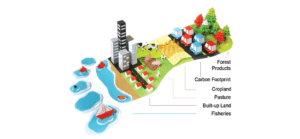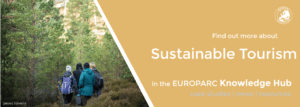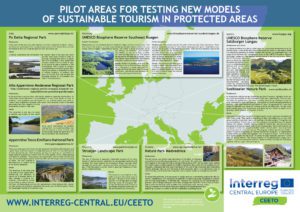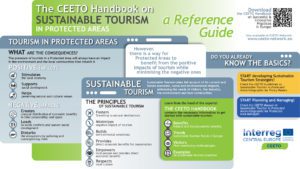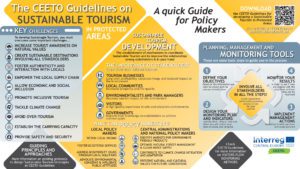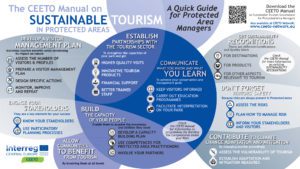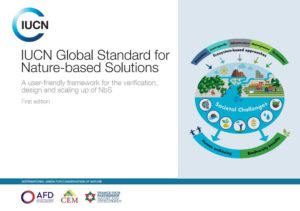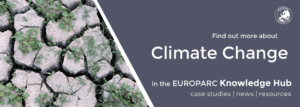Take action to move the Earth Overshoot Day
Earth Overshoot Day marks the date when humanity’s demand for ecological resources and services in a given year exceeds what the planet can regenerate in that year. In 2020, the day has been calculated to land on August 22.
What is the Overshoot Day?
Although the coronavirus pandemic has reduced humanity’s ecological footprint this year, we are still far from using the planet’s resources sustainably in the long term. Global Footprint Network combined the most reliable data, including impacts from the pandemic, and formed assumptions to assess humanity’s current resource situation.
The calculation takes into account factors like changes in carbon emissions, forest harvest, food demand and other figures that could impact global biocapacity.
Among the good news is that the carbon footprint has been reduced by 14.5% from 2019, and the forest product footprint decreased by 8.4% as compared to last year. On the other hand, the food footprint is assumed to remain unchanged, as the pandemic has disrupted global food systems, and possibly increased both food waste and malnutrition among the lowest income populations. Check out more highlights and the full methodology report explaining how the date of Earth Overshoot Day was calculated.
#MoveTheDate with Sustainable Tourism
There are many steps that individuals, communities and businesses can take to lower their ecological footprint and contribute to delaying the global overshoot. These include for example reducing meet consumption, using carbon-free means of transport or cutting down food waste. And how can Protected Areas get involved in that?
Let’s explore, not exploit!
Traveling with eco-sensibility is one of the ways that can play an important role in reducing the society’s footprint. Protected Areas offering ecotourism itineraries, such as the Network of EUROPARC’s Sustainable Destinations, provide such possibilities and serve as a good example.
Measure the ecological footprint of your ecotourism itineraries
Find out what is your destination’s ecological footprint with DestiMED’s Calculator, developed by the Global Footprint Network in collaboration with IUCN Med (International Union for Conservation of Nature) and the MEET Network (Mediterranean Experience of Ecotourism).
Ecotourism is a great tool to promote the unique value of nature and Protected Areas, while creating revenue for local communities.
The free online tool enables to measure and monitor the ecological footprint, based on four main aspects of an ecotourism package: accommodation, food and drinks, mobility and transfer activities, and lastly, services.
Go the the calculator and read how you can achieve a lower ecological footprint!
Sustainable Tourism Management in the Post-Pandemic Reality
Source: Pixabay
Since the coronavirus pandemic restricted the usual international and tourism-related movements of people, many parks and Protected Areas have been facing an increased influx of visitors. On the one hand, the situation represents an opportunity to raise awareness about Protected Area issues, on the other hand, it brings significant challenges for the Protected Area managers – especially in keeping the tourism activities sustainable.
The uncertainty brought by the COVID-19 outbreak in spring forced many European Parks and Protected Areas to adapt and come up with plans to ensure some continuity of their services, safety measures and new operational procedures.
We collected several examples of measures that Parks across Europe developed and put in place in the past weeks and months…
Parks’ Communication
In an effort to ensure that all the new guidelines and other changes are acknowledged by the visitors, Protected Areas had to communicate effectively. The Cairngorms National Park in Scotland published a short instructional video urging tourists to follow the rules to stay safe, and to protect both other visitors and nature.
In a recent newsletter, France Nature Environnement published an article with tips on how to interact with nature after the lockdown and avoid involuntary damage to wildlife which have spread out during confinement.
Compliance rules, Procedures and Enforcement
In Italy, an Anti-contagion protocol for excursions in protected natural areas was prepared by Federparchi with the consultancy of directors, the RomaNatura body and in collaboration with Campus Bio Medico University of Rome. The handbook develops a special protocol for guided visits in protected natural areas and includes the following fundamental points:
- online reservations required as prerequisite for access to guided tours;
- disposable masks and gloves to be used indoors and where necessary;
- body temperature detection at the meeting points of the Visitor Centers;
- groups of up to twelve people with social distance up to two meters, and
- additional protection devices for the guides to be used in case of need.
EUROPARC is still seeking to collect and collate new practice across Europe in order to share and assist members who are having to think this through and develop new operational procedures.
If you have any comments or concerns about what might change in your park in the post COVID world, please feel free to send us an email at europarc@europarc.org!
The CEETO Project – A Reference for Sustainable Tourism Management
Aside from the extensive work carried out by the European Charter for Sustainable Tourism in Protected Areas for about 25 years, other initiatives have taken a step forward in the development of Sustainable Tourism management in our continent. In this line of action and after three years of extensive work, the recently finished CEETO project has become a major reference.
The CEETO project, in which EUROPARC Federation was an active partner, has strived to analyse, design and test new Sustainable Tourism governance models in eight Pilot Protected Areas of Europe and developed a set of outputs that will undoubtedly be of help to support the work of Protected Area managers in Europe:
The Handbook on Successful – Innovative Practices in Europe
This document offers a knowledge basis compiling some of the most successful stories, existing management and monitoring tools and lessons learned across Europe and worldwide about sustainable tourism practices in Protected Areas.
Download the CEETO Handbook. It is available in English, German, Croatian, Hungarian, Italian and Slovenian version!
The Guidelines for a Sustainable Tourism in Protected Areas
The Guidelines were designed as a tool to support policy makers at international, national and regional level in the process of shaping the tourism planning and management within and around Protected Areas. Their main objective is to facilitate the integration of nature conservation, sustainability criteria and principles for concrete environmental and socio-economic benefits into the design process of these plans.
Watch this introductory video and download the CEETO Guidelines. The document is available in English, Slovenian and Italian.
The Manual of Sustainable Tourism governance for Protected Area managers
The last output of CEETO project, the Manual, is an operational document intended for both Protected Area managers and local stakeholders to help them to implement Sustainable Tourism strategies in Prortected Areas. It is based on the experience of eight Protected Areas in Austria, Croatia, Germany, Italy and Slovenia that tested various governance models for stakeholders engagement and monitoring tools of visitors flow, aimed at reducing environmental impacts and pressures of tourism and enhance the socio-economic benefits that can come from a Sustainable Tourism approach.
Download the CEETO Manual, available in English, Italian and Slovenian.
You can find a short video teaser from each of the Pilot Protected Areas by clicking on their descriptions. Here is one from the Biosphere Reserve Salzburger Lungau in Austria:
Additionally, the CEETO project created a network of partners that aims to endure after the project closure: the CEETO network. This network, which is articulated through an online platform, it is formed by practitioners in nature conservation and Sustainable Tourism in Europe that share a common goal: to valorise natural heritage, to contribute to its conservation, and to achieve well-being of local communities through the appropriate management of tourism. The CEETO network is open for new members.
Further information on the main CEETO project outputs can be found on the CEETO Final Conference webpage, an event that gathered more than 200 professionals on Sustainable Tourism and in which the main aspects of the project were presented and discussed, or at the two CEETO webinars that were hosted during the project. Additionally, a summary of the main project results can be found at the CEETO Brochure.
Obituary of Joke Kersten
Joke Kersten
It was with great sadness that EUROPARC learned of the death of Joke Kersten from the Netherlands. Joke lived a life of service, politically as a government minister and laterally as a mayor, but served too, the national parks community in the Netherlands as president of Meinweg National Park and the National Parks Association.
She brought her wisdom, humour and good grace to all her work which was more than apparent in her enthusiastic participation in EUROPARC activities, serving as the president of the then newly founded Low Countries Section.
She will be sorely missed by all in EUROPARC, but her legacy and commitment to the Dutch protected Areas and to their connection in Europe, will continue through all who she inspired.
She will be laid to rest tomorrow in her beloved Limburg, at the all too young age of 76. If you wish to send you condolences and memories please do so through the email uitvaartkersten@gmail.com
EUROPARC send our deepest condolences to her family and all colleagues.
IUCN Global Standard for Nature-based Solutions
Mangroves provide natural protection from climate change impacts. Source: Pixabay.
The current environmental and societal challenges call for highly efficient and sustainable solutions. With that in mind, The International Union for Conservation of Nature (IUCN) recently unveiled the Global Standard for Nature-based Solutions, intended for use by governments, businesses, investors, communities and NGOs.
The first Standard for Nature-based Solutions
The new IUCN Global Standard provides the first-ever set of benchmarks for nature-based solutions to global challenges. The publication should help governments, business and civil society ensure the effectiveness of nature-based solutions and maximise their potential to help address climate change, biodiversity loss and other societal challenges on a global scale.
The world is looking for durable and effective options to tackle global challenges such as climate change, food and water security, and now, economic recovery from the global pandemic,
said Stewart Maginnis, IUCN’s Global Director for the Nature-based Solutions Group. “For nature-based solutions to fulfil their potential, we must ensure that the actions put in place today bring about the desired benefits for society and biodiversity.”
Download and read the IUCN Global Standard here!
Nature-based Solutions around the world
Nature-based Solutions are defined by IUCN as “actions to protect, sustainably manage and restore natural or modified ecosystems that address societal challenges effectively and adaptively, simultaneously providing human well-being and biodiversity benefits”.
Nature-based Solutions have attracted more attention and became more popular over the last years. More than 130 countries have already included these actions – such as reforestation, green infrastructure, sustainable agriculture and aquaculture, or coastal protection – in their national climate plans under the Paris Agreement.
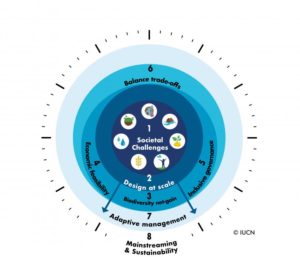
The eight criteria for Nature-based Solutions
However, not all actions labelled as “nature-based solutions” provide the anticipated benefits to both society and biodiversity, and that is why IUCN developed eight criteria and indicators that allow decision-makers to assess the aptness, scale, economic, environmental and social viability of an intervention.
The publication instructs users how to perform a self-assessment with the standard to:
- Design new Nature-based Solutions;
- Upscale pilots by identifying gaps and;
- Verify past projects and future proposals.
In order to consider possible trade-offs, ensure transparency and explore possible linkages to international targets and commitments, the Global Standard includes a user guide and self-assessment tool, identifying areas for improving and learning.
